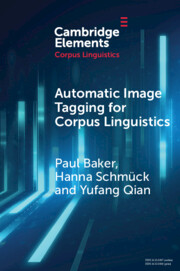Refine search
Actions for selected content:
121 results
6 - A Republic of Medical Letters and Professional Unity
-
- Book:
- Palestinian Doctors
- Published online:
- 12 September 2025
- Print publication:
- 02 October 2025, pp 178-213
-
- Chapter
- Export citation
“Is This Picture Not a Proof?”: Photojournalism and Anti-Colonial Politics in Lagos, 1930s–1950s
-
- Journal:
- African Studies Review / Volume 68 / Issue 2 / June 2025
- Published online by Cambridge University Press:
- 15 August 2025, pp. 227-251
-
- Article
- Export citation
Chapter 4 - The Mid Nineteenth-Century Press and Periodical Poetry
- from Part I - Transacting
-
-
- Book:
- Latinx Literature in Transition, 1444–1886
- Published online:
- 06 August 2025
- Print publication:
- 17 July 2025, pp 106-124
-
- Chapter
- Export citation

Automatic Image Tagging for Corpus Linguistics
- A Multimodal Study of News Representations of Islam
-
- Published online:
- 02 July 2025
- Print publication:
- 24 July 2025
-
- Element
-
- You have access
- Open access
- HTML
- Export citation
1 - A Victorian Conspectus
-
- Book:
- The Guitar in Victorian England
- Published online:
- 09 June 2025
- Print publication:
- 26 June 2025, pp 12-45
-
- Chapter
- Export citation

The Guitar in Victorian England
- A Social and Musical History
-
- Published online:
- 09 June 2025
- Print publication:
- 26 June 2025
1 - “These Things Happened”: The Rebellion
-
- Book:
- A Lesson on Race
- Published online:
- 22 May 2025
- Print publication:
- 05 June 2025, pp 12-29
-
- Chapter
- Export citation
3 - “A Good Fight”: George William Gordon
-
- Book:
- A Lesson on Race
- Published online:
- 22 May 2025
- Print publication:
- 05 June 2025, pp 50-67
-
- Chapter
- Export citation
6 - “Produce Your Cause”: The Bible
-
- Book:
- A Lesson on Race
- Published online:
- 22 May 2025
- Print publication:
- 05 June 2025, pp 106-122
-
- Chapter
- Export citation
4 - “Dead, Yet Speaketh”: Robert Johnson
-
- Book:
- A Lesson on Race
- Published online:
- 22 May 2025
- Print publication:
- 05 June 2025, pp 68-86
-
- Chapter
- Export citation
Introduction
-
- Book:
- A Lesson on Race
- Published online:
- 22 May 2025
- Print publication:
- 05 June 2025, pp 1-11
-
- Chapter
- Export citation
Chapter 3 - Centro America in San Francisco
- from Part I - Space
-
-
- Book:
- Latinx Literature in Transition, 1848–1992
- Published online:
- 10 April 2025
- Print publication:
- 17 April 2025, pp 54-72
-
- Chapter
- Export citation
3 - Why Are Some States More Corrupt than Others?
- from Part I - How Corrupt Is America?
-
- Book:
- Corruption in America
- Published online:
- 21 March 2025
- Print publication:
- 03 April 2025, pp 33-54
-
- Chapter
- Export citation
7 - Communicative Strategies in News Reports
- from Part Two - Key Topics
-
- Book:
- Language and Politics
- Published online:
- 20 February 2025
- Print publication:
- 27 February 2025, pp 120-132
-
- Chapter
- Export citation
Advertising, Piano Culture, and the Changing Middle Class in Urban Galicia, 1911–1921
-
- Journal:
- Austrian History Yearbook / Volume 56 / May 2025
- Published online by Cambridge University Press:
- 24 February 2025, pp. 132-149
- Print publication:
- May 2025
-
- Article
- Export citation
4 - Modern Times
-
- Book:
- Exhibitionist Japan
- Published online:
- 06 February 2025
- Print publication:
- 13 February 2025, pp 97-124
-
- Chapter
- Export citation
Afterword
- from Part V - Civil Society and Tackling Disinformation
-
-
- Book:
- Disinformation, Misinformation, and Democracy
- Published online:
- 09 January 2025
- Print publication:
- 23 January 2025, pp 399-414
-
- Chapter
-
- You have access
- Open access
- HTML
- Export citation
Chapter 4 - Dutch-Speaking Runaway Slaves in New York and New Jersey
-
- Book:
- The Slow Death of Slavery in Dutch New York
- Published online:
- 20 December 2024
- Print publication:
- 09 January 2025, pp 115-139
-
- Chapter
- Export citation
Chapter 5 - Civil War, Guerre de Plume, and the Emergence of Early Haitian Periodical Culture
-
-
- Book:
- A History of Haitian Literature
- Published online:
- 07 November 2024
- Print publication:
- 21 November 2024, pp 75-94
-
- Chapter
- Export citation
Local Newspaper Decline and Political Polarization – Evidence from a Multi-Party Setting
-
- Journal:
- British Journal of Political Science / Volume 54 / Issue 4 / October 2024
- Published online by Cambridge University Press:
- 23 October 2024, pp. 1256-1275
-
- Article
-
- You have access
- Open access
- HTML
- Export citation
